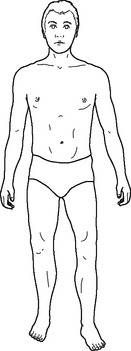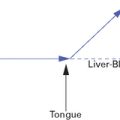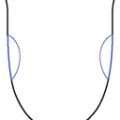 OBSERVATION OF THE BODY SHAPE, PHYSIQUE AND DEMEANOUR
OBSERVATION OF THE BODY SHAPE, PHYSIQUE AND DEMEANOUR
CLASSIFICATION OF BODY SHAPE ACCORDING TO YIN AND YANG
CLASSIFICATION OF BODY SHAPE ACCORDING TO THE FIVE ELEMENTS
CLASSIFICATION OF BODY SHAPE ACCORDING TO PRENATAL AND POSTNATAL INFLUENCES
Body shape with strong prenatal constitution
Body shape with weak prenatal constitution
CLASSIFICATION ACCORDING TO BODY BUILD
CLASSIFICATION OF BODY SHAPE ACCORDING TO PAIN AND DRUG TOLERANCE
INTRODUCTION
The body shape of a person is determined by the prenatal constitution and subsequent postnatal nourishment: for this reason, the body shape of a person can give us an indication both of the constitutional tendency to a certain pathology and of an actual pathology resulting from postnatal influences. Observation of the body (including size, height, tone of skin and muscles, length of bones, etc.), as well as of demeanour and personality, is important to assess the constitution of a patient. Chapter 21 of the “Simple Questions” says, “In diagnosing diseases one should observe whether the patient is extrovert or timid and observe the state of the bones, muscles and skin in order to understand the condition so that we can diagnose and treat.”1 There are five different ways of classifying the body shape in Chinese medicine, which are described below:
CLASSIFICATION OF BODY SHAPE ACCORDING TO YIN AND YANG
The possible body shapes according to Yin and Yang are:
Chapter 31 of Volume 4 of the “Classic of Categories” (Lei Jing, 1624) summarizes the characteristics of people with a constitutional excess of Yin, people with a constitutional excess of Yang and people with a balance of Yin and Yang:
People gifted with pure Yin are known as the Greater-Yin type; those with a mixture of Yin and Yang but more Yin than Yang are known as the Lesser-Yin type; those with pure Yang are known as the Greater-Yang type; those with a mixture of Yin and Yang but more Yang than Yin are known as the Lesser-Yang type. Together with the type of people with equal Yang and Yin, these constitute the five different types of people. Therefore, for people with abundant-Yang constitution, it is advisable to use cooling methods of treatment. For people with abundant-Yin constitution, it is advisable to use warming methods of treatment.2
Body shape abundant in Yang
Observation
The body shape, demeanour and personality of a person with abundant Yang are as follows: strong body build, tendency to a red face, preference for cold, intolerance of heat, preference for light clothes, lively character, active and talkative nature, loud voice, tendency to laugh, tendency to being a high achiever, decisiveness, assertiveness, walking with the chest and stomach projecting forward (Fig. 1.1).
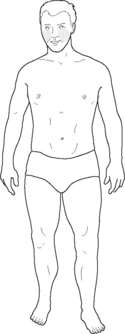
Fig. 1.1 Body shape abundant in Yang
Quotations from the classics
The “Spiritual Axis” in Chapter 72 says:
A Greater-Yang type of person looks arrogant with the chest and stomach projected forward as if the body was bending backwards. This is the picture of a Greater-Yang type of person. A Lesser-Yang type of person holds the head high while standing, and shakes the body while walking. The two hands are often held behind the body with the arms and elbows exposed on the side of the body. This is the picture of a Lesser-Yang type of person.3
A Greater-Yang type of person has excess of Yang and deficiency of Yin and it is necessary to examine them with great care and treat them so that the Yin is not reduced to the point of collapse. The Yang must be reduced but not excessively to the point of collapse, lest the patient develops madness.4
Chapter 67 of the same book says:
A person with abundant Yang is emotional and as warm as fire; he talks fast and is swollen with arrogance. It is because the Heart- and Lung-Qi of such a person are abundant; Yang-Qi is therefore plentiful and flows freely and vigorously. For this reason, it is easy to stimulate his spirit, and the Qi arrives quickly when acupuncture is given.5
People with abundant Yang hold their head high while standing because it is in the nature of Yang to rise. They shake their body while walking because it is in the nature of Yang to move. They often hold their hands behind the body with the arms and elbows by the sides of the body as it is in the nature of Yang to be exposed. This is the picture of the personality of the Lesser-Yang type of people.6
The six external pathogenic factors attack people in the same way but diseases caused by them will have different manifestations in different people. Why? The reason is that a person’s body can be either strong or weak, Qi can be full or deficient, and the internal organs can be of cold or hot. After the external pathogenic factors invade the body, they will transform according to the condition of the internal organs. Therefore, the syndromes vary. They can transform into deficient or excessive conditions, and into cold or hot conditions.7
Body shape abundant in Yin
Observation
The typical characteristics of a person of the abundant-Yin type are: a tendency to obesity, relatively dark complexion, loose muscles with thick skin, quiet, reticent and introverted nature, soft voice, a preference for heat and a desire to wrap up warm (Fig. 1.2).
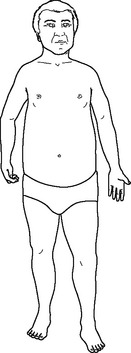
Fig. 1.2 Body shape abundant in Yin
Quotations from the classics
Chapter 72 of the “Spiritual Axis” says:
Persons of the Greater-Yin type have a sombre countenance and pretend to be humble. They have the body build of a grown-up, but make themselves smaller by bending their back and knees slightly. This is the picture of a Greater-Yin type of person … They are restless while standing, and walk as if to hide themselves. This is the picture of a Lesser-Yin type of person.8
Persons of the Greater-Yin type are constitutionally excessive in Yin and deficient in Yang. Their Yin and Blood are thick and turbid. Their Defensive Qi does not flow freely. Yin and Yang are not in a harmonious state, which leads to loose sinews and thick skin. When needling patients with an abundant-Yin constitution, only through reducing the Yin quickly and immediately can an improvement be expected.9
The Yellow Emperor asks: “How is it that sometimes the body will react only after several acupuncture treatments?” Qi Bo answers, “Such a person is excessive in Yin and deficient in Yang. The movement of Qi is restrained and therefore it is difficult for Qi to arrive when the patient is needled. This is the reason why the body will react to the acupuncture only after several treatments.10
Body shape deficient in Yang
Observation
The typical characteristics of a person with the deficient-Yang type of body shape are as follows: overweight/swollen body, pale or pale-bluish complexion, listlessness, low spirits, slow movement, weak, loose muscles, a preference for warmth, aversion to cold, cold limbs and a desire to wrap up (Fig. 1.3).

Fig. 1.3 Body shape deficient in Yang
Body shape deficient in Yin
Observation
The typical characteristics of a person with a deficient-Yin type of body shape are as follows: thin body build, sometimes red cheeks and lips, an excited look, a restless expression in eyes, a propensity to be excited, a feeling of heat and quick movements. People of Yin-deficient body shape are often deficient in Yin and excessive in Yang. The body is thin and tall with a long-shaped head, thin long neck, narrow shoulders and a narrow, long, flat chest. These people often bend forward when they walk or stand (Fig. 1.4).
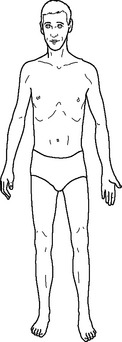
Fig. 1.4 Body shape deficient in Yin
Body shape with Yin and Yang in balance
Observation
The body shape with harmony of Yin and Yang is of medium build, not too tall or short, neither too stout nor thin. The movements are balanced and the personality is stable. People with such a constitution are better able to adapt themselves to changes caused by the stresses of life (Fig. 1.5).
CLASSIFICATION OF BODY SHAPE ACCORDING TO THE FIVE ELEMENTS
The body shapes according to the Five Elements are:
Wood type
Observation
People of the Wood type have a subtle shade of green in their complexion, a relatively small head and long-shaped face, broad shoulders, straight back, tall, sinewy body and elegant hands and feet. In terms of personality, they have developed intelligence but their physical strength is poor. Hard workers, they think things over and tend to worry (Fig. 1.6, see also Plates 1.1 and 1.2 on p. P1).
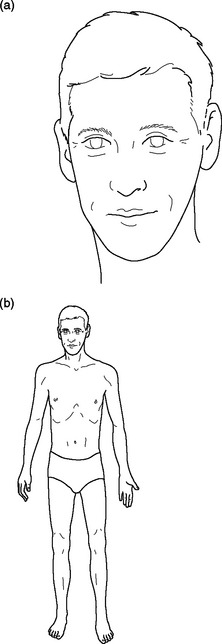
Fig. 1.6 Wood type: (a) face; (b) body
Quotations from the classics
Chapter 64 of the “Spiritual Axis” says:
The Wood type of people correspond to Shang Jiao of the note Jiao, which is one of the five notes and is related to the element of Wood. Their complexion colour is similar to that of the Green Emperor, who is one of the five heavenly emperors, and represents the East. Their complexion has a subtle green colour, they have a small head, long-shaped face, broad back and shoulders, straight body trunk and small hands and feet. They are intelligent, and keep their mind working hard. They are not strong physically. The are often worried. They like Spring and Summer and dislike Autumn and Winter.12
People of the Wood type can tolerate Spring and Summer but not Autumn or Winter. In Autumn or Winter, they suffer from diseases caused by invasion of pathogenic factors.13
People of the Wood type respond to the colour green, which is at its best when, like green wood, there is moisture in it. People of the Wood type have a straight body just like the trunk of a tree. They have the so-called five kinds of Smallness, i.e. a small head, small hands and small feet, just like the twigs of a tree. They have the so-called five kinds of Thinness and Length, implying a long, thin body trunk and limbs, like the branches of a tree. Just as wood has various uses and can be cut in different ways as wanted, people of the Wood type are versatile, and are apt to intellectual work. Just as wood is seldom quiet [i.e. always swaying in wind and breeze], people of the Wood type tend to worry, and are often exhausted by what they do. If wood is not straight but is short and soft, it is not good timber for use.14
Box 1.1 summarizes the characteristics of the Wood type.
Fire type
Observation
People of the Fire type have a red, florid complexion, wide teeth, a pointed, small head, possibly with a pointed chin, hair that is either curly or scanty, well-developed muscles of the shoulders, back, hips and head and relatively small hands and feet. In terms of personality, they are keen thinkers. The Fire type is quick, energetic and active. They are short-tempered. They walk firmly and shake their body while walking. They tend to think too much and often worry. They have a good spirit of observation and they analyse things deeply (Fig. 1.7, see also Plate 1.3 on p. P1).

Fig. 1.7 Fire type: (a) face; (b) body
Quotations from the classics
Chapter 64 of the “Spiritual Axis” says:
People of the Fire type correspond to Shang Zhi of the note Zhi, which is one of the five notes, and is related to the element of Fire. The colour of their complexion is similar to that of the Red Emperor, who was one of the five heavenly emperors, and represents the South. They have a red complexion, wide teeth, a thin small face, small head, well-developed and nice-looking shoulders, back, thighs and abdomen. They have small hands and feet. They walk with quick steps but tread the ground softly and soundlessly, and their body shakes as they walk. They are short-tempered. They act boldly and make light of money, but they are not trustworthy. They worry too much. They have a good sense of judgment. The colour of their complexion is attractive, but they are short-tempered. They like Spring and Summer and dislike Autumn and Winter.15
People of the Fire type have a short life often ending with a sudden death. They can tolerate Spring and Summer but not Autumn or Winter. In Autumn or Winter they will suffer from diseases caused by invasion of pathogenic factors.16
The chapter “Keys to the Four Diagnostic Methods” of the “Golden Mirror of Medicine” says:
People of the Fire type have a red complexion which is best when it is also bright [i.e. with shen]. They have the so-called Five Pointed Structures, i.e. a pointed head, forehead, nose, face and mouth: they are similar to the pointed shape of a flame when it flares up … People of the Fire type are bold and daring because Fire is Yang in nature and rich in Qi. They make light of money, which is similar to the scattering nature of Fire. They are not trustworthy for just like a fire they are constantly changing. They tend to worry, mirroring the flickering of a flame. They move constantly just like a fire which is always moving. They are short-tempered, sharing fire’s quickness and suddenness. If these people have symptoms of mental confusion and abnormality of Qi and colour, it means that their body is in disharmony.17
Box 1.2 summarizes the characteristics of the Fire type.
Earth type
Observation
People of the Earth type have a yellowish complexion, round-shaped face, relatively big head, wide jaws, well-developed and nice-looking shoulders and back, large abdomen, strong thigh and calf muscles, relatively small hands and feet, and well-built muscles of the whole body. They walk with firm steps without lifting their feet very high. The Earth type is calm and generous, has a steady character, likes to help people and is not overambitious. It is easy to get on with (Fig. 1.8, see also Plate 1.4 on p. P1).
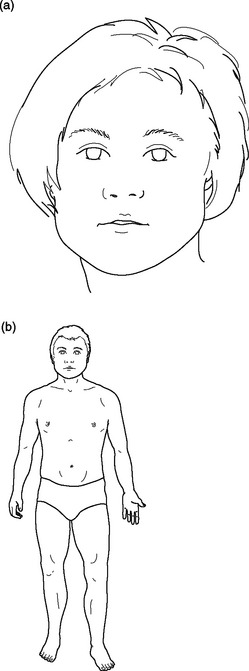
Fig. 1.8 Earth type: (a) face; (b) body
Quotations from the classics
Chapter 64 of the “Spiritual Axis” says:
The Earth type of people correspond to Shang Gong of the note Gong which is one of the five notes, and is related to the element of Earth. Their complexion is similar in colour to that of the Yellow Emperor, who is one of the five heavenly emperors and represents the Centre. They have a yellow complexion, round-shaped face, large head and well-developed and nice-looking shoulders and back. The abdomen is large and their thighs and legs strong and well-built. They have small hands and feet, but well-developed muscles. Every part of their body, from the upper to the lower, is well proportioned. They walk steadily, and are trustworthy. They are calm and like to help people. They are not interested in pursuing power or position. They like to establish good relations with other people. They like Autumn and Winter and dislike Spring and Summer.18
The chapter “Key to the Four Diagnostic Methods” of the “Golden Mirror of Medicine” says:
People of the Earth type respond to the yellow colour, which is best when it is also shiny. They have the so-called Five Kinds of Roundness similar to the round shape of the Earth. They have the so-called Five Kinds of Solidity and Thickness which in nature resemble the solid Earth. They have the so-called Five Kinds of Shortness which is similar to the appearance of the Earth being solid and short. Although people with the Earth type of body have the characteristics of roundness, solidity, thickness and shortness, each person will have a particular, individual shape. The round face, the big head, the large abdomen and the well-built shoulders and legs all resemble the dense and solid appearance of the Earth. People of the Earth type are sincere and trustworthy. They take their time in doing things. They are calm at heart. All these characteristics mirror the nature of Earth in being honest and reliable.19
Box 1.3 summarizes the characteristics of the Earth type.
Metal type
Observation
People of the Metal type have a relatively pale complexion, a square-shaped face, a relatively small head, small shoulders and upper back, a relatively flat abdomen, and small hands and feet. They have a strong voice, move swiftly and have keen powers of thought. They are honest and upright. They are generally quiet and calm in a solid way, but also capable of decisive action when necessary. They have a natural aptitude for leadership and management (Fig. 1.9, see also Plate 1.5 on p. P2).
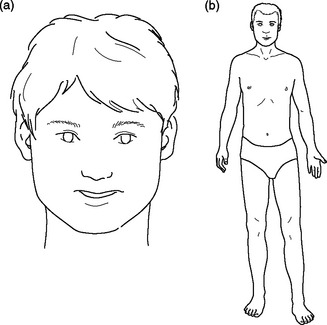
Fig. 1.9 Metal type: (a) face; (b) body
Quotations from the classics
Chapter 64 of the “Spiritual Axis” says:
People of the Metal type correspond to Shang [a musical note] while keeping still, but are intrepid and fierce when active. They have a natural aptitude for leadership and management … People of the Metal type correspond to Shang, which is one of the five notes and is related to the element of Metal. Their complexion is similar to that of the White Emperor, who is one of the five heavenly emperors and represents the West. They have a relatively pale complexion, a small head, small shoulders and upper back, a flat abdomen, and small hands and feet. They have strong heels as if the bones grew outside rather than in. They are quick and swift in movement, and are honest and upright in personality. They are short-tempered. They appear quiet and calm when keeping still, but fierce and bold once they make a move. They have the talent to be officials. They like Autumn and Winter and dislike Spring and Sumner.20
People of the Metal type can tolerate Autumn and Winter but not Spring or Summer when they may suffer diseases from invasion of external pathogenic factors.21
The chapter “Keys to the Four Diagnostic Methods” of the “Golden Mirror of Medicine” says:
People of the Metal type correspond to the colour white and their complexion is best when it is pure. They have the so-called Five Kinds of Squareness similar to the square structure of metal. They have the so-called Five Kinds of Moisture similar to the quality of metal under water. Individuals who deviate from the typical characteristic of Metal may not display square and regular features. If the muscles become thinner, their bones will show. These are all signs of exhaustion. People of the Metal type are quiet and calm when keeping still but fierce once in action. This mirrors the nature of metal which is silent and resilient. People of this kind are honest and upright as metal is pure and strong in quality. As officials, people of the Metal type are awesome and dignified just as metal is solemn.22
Box 1.4 summarizes the characteristics of the Metal type.
Water type
Observation
People of the Water type have a relatively dark complexion, wrinkles, a relatively big head, a round face and body, broad cheeks, narrow and small shoulders and a large abdomen. They keep their body in motion while walking and find it difficult to keep still. They have a long spine. The Water type is sympathetic and slightly laid-back. They are good negotiators and loyal to their work colleagues. They are aware and sensitive (Fig. 1.10, see also Plates 1.6 and 1.7 on p. P2).
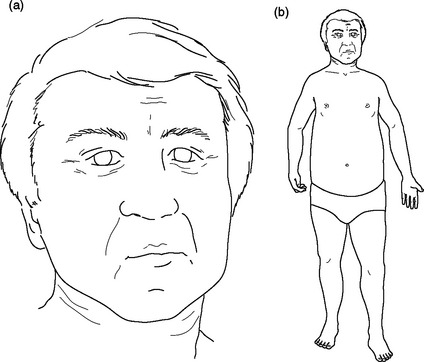
Fig. 1.10 Water type: (a) face; (b) body
Quotations from the classics
Chapter 64 of the “Spiritual Axis” says:
People of the Water type correspond to Shang Yu of the note Yu, which is one of the five notes and is related to the Water element. Their complexion is similar in colour to that of the Black Emperor, who was one of the heavenly emperors and represents North. They have a relatively dark complexion, wrinkled face, a big head, broad cheeks, small shoulders and a large abdomen. Their hands and feet are seldom at rest, and their body quivers while walking. They have a long spine. They like Autumn and Winter and dislike Spring and Summer.23
The chapter “Keys to the Four Diagnostic Methods” in the “Golden Mirror of Medicine” says:
People of the Water type correspond to the colour purple, and their complexion is best when it possesses lustre. Their face is fat and uneven just as the sea’s surface is vast and rolling with waves. They have the so-called Five Kinds of Fatness just as water is wide. They have the so-called Five Kinds of Tenderness mirroring the moistness of water. They have the so-called Five Kinds of Smoothness resembling the clear nature of water. With a fat body build, people of the Water type tend to have a mobile body when they walk, mirroring the flowing movement of water. This kind of people have no respect for anybody nor do they fear; like water, they always run to a lower place. They pretend to be humble but actually tend to be deceivers; water, too, feels empty and lacking a solid structure.24
Box 1.5 summarizes the characteristics of the Water type.
Clinical application of the Five Element types
Secondly, each Element type should have a strong point (Box 1.6) and a weakness in that area indicates a poor prognosis. For example, people of the Wood type should have strong sinews; if they do not, it indicates a possible illness. People of the Fire type should walk fast and their strong point should be the Heart and blood vessels; for the Fire type to walk slowly indicates a potential problem. People of the Earth type should have strong muscles; if they do not it indicates a weakness in the Stomach and Spleen and the tendency to rheumatism. People of the Metal type should walk slowly and deliberately and their voice should be strong; if they walk fast and their voice is weak it indicates a potential problem. People of the Water type should have strong Kidneys and may easily suffer from overindulgence in sexual activity.
CLASSIFICATION OF BODY SHAPE ACCORDING TO PRENATAL AND POSTNATAL INFLUENCES
The body shapes according to prenatal and postnatal influences are as follows:
Body shape with strong prenatal constitution
Clinical significance
The above features indicate a good prenatal constitution: when this person is ill, the disease is easy to treat. People with a strong prenatal constitution generally have a long life and they are able to survive even serious illnesses. A strong prenatal constitution often explains why one person can survive a serious disease such as cancer, where another person does not. A person with a strong constitution may also “get away with” living in an unhealthy way and still live a long life. Of course, it is also possible to ruin a good prenatal constitution through unhealthy living. A good prenatal constitution is very often the crucial determining factor in prognosis.
To summarize, the main features indicating a good prenatal constitution are as follows (Fig. 1.11):

Fig. 1.11 Good prenatal constitution
Quotations from the classics
Chapter 37 of the “Spiritual Axis” says:
A life as long as 100 years can be expected if the forehead and glabella are full and broad; the cheek and the area from the cheek to the front of the ear have well-developed muscles and protrude from the face, connecting a strong lower jaw and long ear lobes together; the eyes, nose, ears and mouth are well spaced and well proportioned; the face colour is normal. These people have abundant Qi and Blood. Their skin and muscles are strong. They respond well to acupuncture treatment.25
Chapter 54 of the same book says:
A person will have a long life if the five Yin organs are strong, blood circulates normally without obstruction, the skin is firm, the circulation of Nutritive and Defensive Qi is normal, breathing is regular, Qi circulates smoothly, and the six Yang organs transform and transport the food essences and body fluids smoothly to all parts of the body, maintaining its normal physiological functions … People with long life expectancy have long and deep nostrils. The muscles of the cheek and of the area from the cheek to the front of the ear are thick and high and well formed. The circulation of Nutritive and Defensive Qi is smooth. The upper, middle and lower parts of the face are in the right proportion, with well-developed and distinct muscles and prominent bones. People of this type can live out their normal life expectancy, or even up to the age of 100.26
Chapter 6 says:
People with a strong body build and relaxed skin, in whom Qi flows smoothly, will live a long life; while those with a strong body build but tense skin, in whom Qi stagnates, will die young. A strong build, a big pulse and a firm Exterior and Interior are signs of longevity; a strong build but a weak, empty pulse, a deficient Interior and a strong Exterior, with empty Qi, indicate a short life. A strong build but hollow, small zygomatic bones indicate weak bones and a short life expectancy; a strong build with well-developed muscles indicates long life; a strong build but with weak and underdeveloped muscles indicates a short life. These are all signs of pre-natal constitution which give an indication of life expectancy. As medical practitioners, we must understand the connection between body build and body shape so that we may have an idea of the patient’s life expectancy.27
The chapter “Keys to the Four Diagnostic Methods” in the “Golden Mirror of Medicine” says: “If the forehead is high, the glabella is full, the nose is high and straight, the cheeks are full and the skeleton is well built, the person will have a long life expectancy.”28
Body shape with weak prenatal constitution
Observation
The physical features of people with a weak prenatal constitution are as follows: the eyes, nose, ears and mouth are close together; the forehead is narrow and the space between the eyebrows small; the nose is narrow with nostrils turned up and exposed; the philtrum is short; the cheek and the area between the cheek and the front of the ears are narrow; the ears are short, small and turning outwards; the lower jaw is flat, sunken, low and narrow; breathing is coarse and the skin is loose (Fig. 1.12).
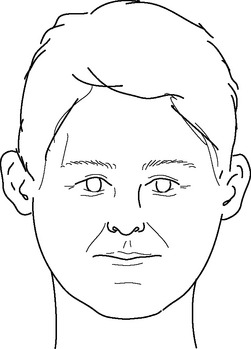
Fig. 1.12 Weak prenatal constitution
Quotations from the classics
Chapter 37 of the “Spiritual Axis” says:
When the five senses are not sharp, the forehead and glabella are narrow, the nose is small, the area between the cheek and the front of the ears is narrow, the lower jaw is flat and the ears turn outwards, the pre-natal constitution is poor even though the complexion and colour may be normal. These people are intrinsically unhealthy, even more so when they are ill.29
Chapter 54 of the same book says:
When the five Yin organs are weak, the nostrils are small and splay outwards, breathing is shallow, the cheek muscles are sunken, the pulse is thin and weak and the muscles are loose, the person is easily invaded by Wind-Cold. As a result, Qi and Blood become more deficient, and the circulation in the vessels is impaired, which will predispose the person to further invasions of pathogenic factors.30
Body shape with strong Postnatal Qi
Observation
Physical features indicating strong Postnatal Qi are as follows: ruddy complexion with lustre, strong body build with solid muscles and firm, elastic skin, shiny hair with moisture, vigour and swift movements (Fig. 1.13).
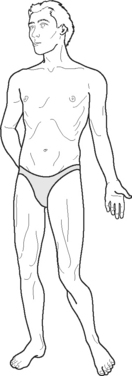
Fig. 1.13 Strong Postnatal Qi
Quotations from the classics
If the pre-natal constitution is good, life will be long; if the pre-natal constitution is weak, life may be short. If people with a good pre-natal constitution take care of their post-natal Qi [with a good lifestyle and diet], they may live even longer; if people with a poor pre-natal constitution do not take care of their post-natal Qi [instead following a poor lifestyle and diet], their life may be even shorter. The build of the skeleton depends on the pre-natal constitution, while the build of the muscles depends on the post-natal Qi. The spirit [Shen] reflects the pre-natal constitution, while the complexion reflects the post-natal Qi. A deep colour of the complexion indicates long life, while a tender, light colour may indicate a short life. A strong, loud voice may indicate a long life, while a feeble voice may indicate a short one. A strong body build may indicate a long life while a weak body build may indicate a short one. One should also differentiate the mental state, paying attention to whether it is calm or restless: a calm mental state may indicate long life while a restless mental state may indicate a short one. As for the development of the body in youth, if a person appears weak when young, but grows stronger as he or she grows up, it is a good sign.31
Body shape with weak Postnatal Qi
Observation
The physical features of people with weak Postnatal Qi are as follows: poor energy, haggard, sallow complexion, dry, withered hair, a thin, small build and loose skin without elasticity (Fig. 1.14).
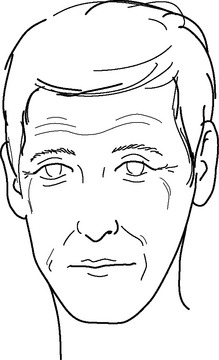
Fig. 1.14 Weak Postnatal Qi
Quotations from the classics
The “Complete Works of Jing Yue” says:
A person’s life expectancy is determined by their pre-natal constitution. If the pre-natal constitution is good and the person receives good post-natal Qi, life expectancy may be long. If the pre-natal constitution is deficient, and the post-natal Qi is poor, life expectancy will be short. If people pay attention to this [i.e. influencing the pre-natal constitution through the post-natal nourishment], those with a short life expectancy can increase it. If people neglect these factors [i.e. they ruin their pre-natal constitution through poor post-natal Qi], those with a high life expectancy can decrease it. What we are born with [i.e. our pre-natal constitution] can exceed what we can reach by our efforts [i.e. our post-natal Qi]; conversely, what can be reached by our efforts [i.e. our post-natal Qi] can exceed what we were born with [i.e. our pre-natal constitution]. The pre-natal constitution is largely determined by that of the parents while the post-natal Qi is determined by our own efforts.32
CLASSIFICATION ACCORDING TO BODY BUILD
Chapters 38 and 59 of the “Spiritual Axis” describe five types of body shape: robust, compact, muscular, thin and overweight. The physical characteristics of these five types generally coincide with those according to Yin and Yang mentioned above; for example, the robust type has a tendency to abundance of Yang, the thin type has a tendency to deficiency of Blood or Yin, the overweight type has a tendency to deficiency of Yang, etc.
The classification of the body type according to body build is as follows:
Robust type
Observation
People of the robust type have large, firm muscles, smooth moist skin, a large abdomen, intolerance to heat and a preference for cold. Figure 1.15 shows a robust body type.

Fig. 1.15 Robust body type
Compact type
Observation
People of the compact type have the following physical features: a small skeleton, compact solid muscles, thick fat under the skin and a small but full body build. Figure 1.16 shows a compact body type.
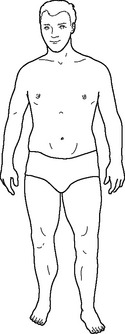
Fig. 1.16 Compact body type
Clinical significance
The above-mentioned physical features indicate that the person has a smooth circulation of Qi and Blood, but he or she may also have a tendency to Qi and Blood deficiency. The diseases these people suffer from are either Cold in nature due to deficiency of Qi, or are Hot in nature due to deficiency of Blood.
Quotations from the classics
Chapter 59 of the “Spiritual Axis” says: “The muscles of compact type of people are compact and solid, and their skin is full and tight … People with a compact body build have compact muscles but a small body … Although people with a compact body build have some fat, their body build is not big.”34
Muscular type
Observation
The physical features of people of the muscular type are as follows: large skeleton, plump and solid body build with the skin and muscles compacted tightly together. Figure 1.17 shows a muscular body type.
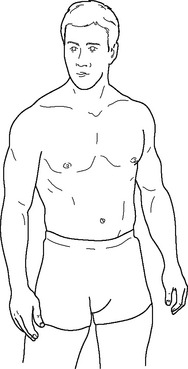
Fig. 1.17 Muscular body type
Quotations from the classics
Chapter 59 of the “Spiritual Axis” says: “People of the muscular type have skin and muscles tightly compacted together … big, broad body size … and large limbs” and also: “People of the muscular type have abundant Qi, their body build is full and strong and their Qi is harmonious.”35
Thin type
Observation
People of the thin type have the following physical features: thin body build, thin muscles and lips and a feeble voice. Figure 1.18 shows a thin body type.
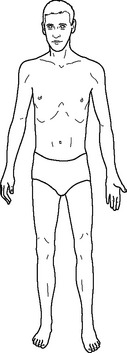
Fig. 1.18 Thin body type
Quotations from the classics
Chapter 38 of the “Spiritual Axis” says: “Thin type of people have thin pale skin as well as thin muscles and lips. They talk in a feeble voice. Their Blood is clear, and their Qi is smooth and slippery. Their Qi will dissipate easily, and their Blood will exhaust easily. Therefore, when needling these people, insertion should be superficial and the needles should be withdrawn quickly.”36
CLASSIFICATION OF BODY SHAPE ACCORDING TO PAIN AND DRUG TOLERANCE
The body shape may be classified according to drug and pain tolerance as follows:
Body shape indicating high pain and drug tolerance
Quotations from the classics
Chapter 53 of the “Spiritual Axis” says:
The Yellow Emperor asks Shao Yu: “People’s tendons and bones can be strong or weak, the muscles can be solid or loose, the skin can be thick or thin, the space between skin and muscles can be firm or weak, how does this affect people’s tolerance of pain caused by needling and the burning of the moxa? People’s stomach and intestines can be strong or weak, how does this affect their tolerance of medicinal drugs? I hope that you will explain this to me in detail.” Shao Yu answers: “People with strong bones, soft tendons, relaxed muscles and thick skin, have a strong tolerance to pain. They can tolerate pain caused by needling as well as the burning of moxa.” The Yellow Emperor asks: “How can you know that people can tolerate the burning pain of moxibustion?” Shao Yu answers: “In the above-mentioned people who have strong bones, soft tendons, relaxed muscles and thick skin, if their complexion colour is relatively dark and their skeleton is well-built and strong, they can tolerate the burning pain of moxibustion. People with a thick stomach, dark complexion colour, solid skeleton and a large body build have sufficient Qi and Blood. They have a good tolerance to medicinal drugs.”37
Chapter 50 of the same book says:
The Yellow Emperor says: “The tolerance of pain does not depend only on the courage of a person. A person who is brave but intolerant of pain, will act without fear in a difficult and dangerous situation, but he or she cannot stand pain. Vice versa, a person who is cowardly but tolerant of pain, will be panic-stricken in a difficult and dangerous situation, but he or she will tolerate pain. A person who is brave and also tolerant of pain is not afraid in a difficult and dangerous situation and can also tolerate pain. A person who is timid and intolerant of pain will be overwhelmed by difficulties, danger or pain: these people will be so afraid that their heads spin and their vision is blurred; they lose their voices and become pale; they cannot look people in the eye and their hearts beat violently. They are scared to death. I have encountered all these kinds of people, but I do not know what the causes are. I would like to know the reasons.” Shao Yu answers: “Tolerance to pain depends on whether the skin is thin or thick and the muscles are solid or weak and loose or tense. It cannot be determined by the bravery or cowardice of a person.”38
Chapter 70 of the “Simple Questions” says: “For people who have strong drug tolerance, use medicines with strong flavours and medicinal action. For people who have weak drug tolerance, use medicines of mild flavour and medicinal action.”39
NOTES
1. The Yellow Emperor’s Classic of Internal Medicine – Simple Questions (Huang Di Nei Jing Su Wen  ). People’s Health Publishing House: Beijing, 1979:138 First published c. 100BC
). People’s Health Publishing House: Beijing, 1979:138 First published c. 100BC
2. Bin, Zhang Jie. Classic of Categories (Lei Jing  ). Beijing: People’s Health Publishing House, 1982; 99. [First published in 1624].
). Beijing: People’s Health Publishing House, 1982; 99. [First published in 1624].
3. Spiritual Axis (Ling Shu Jing  ). People’s Health Publishing House: Beijing, 1981:129 First published c. 100BC
). People’s Health Publishing House: Beijing, 1981:129 First published c. 100BC
4. Spiritual Axis (Ling Shu Jing  ). People’s Health Publishing House: Beijing, 1981; 130.
). People’s Health Publishing House: Beijing, 1981; 130.
5. Spiritual Axis (Ling Shu Jing  ). People’s Health Publishing House: Beijing, 1981; 123.
). People’s Health Publishing House: Beijing, 1981; 123.
6. Qian, Wu. Golden Mirror of Medicine (Yi Zong Jin Jian  ). Beijing: People’s Health Publishing House, 1977; 889. [vol. 2, First published in 1742].
). Beijing: People’s Health Publishing House, 1977; 889. [vol. 2, First published in 1742].
7. Cited in Sheng, Zhang Shu. Great Treatise of Diagnosis by Observation in Chinese Medicine (Zhong Hua Yi Xue Wang Zhen Da Quan  ). Taiyuan: Shanxi Science Publishing House, 1995; 44.
). Taiyuan: Shanxi Science Publishing House, 1995; 44.
14. Golden Mirror of Medicine, vol. 2, p. 885
17. Golden Mirror of Medicine, p. 885
19. Golden Mirror of Medicine, vol. 2, p. 886
22. Golden Mirror of Medicine, vol. 2, p. 886
24. Golden Mirror of Medicine, vol. 2, pp. 886–887
28. Golden Mirror of Medicine, vol. 2, p. 871
31. Yue, Zhang Jing. The Complete Works of Jing Yue (Jing Yue Quan Shu  ). Shanghai: Shanghai Science and Technology Press, 1986; 19. [First published in 1624].
). Shanghai: Shanghai Science and Technology Press, 1986; 19. [First published in 1624].
32. Yue, Zhang Jing. The Complete Works of Jing Yue (Jing Yue Quan Shu  ). Shanghai: Shanghai Science and Technology Press, 1986; 19.
). Shanghai: Shanghai Science and Technology Press, 1986; 19.

